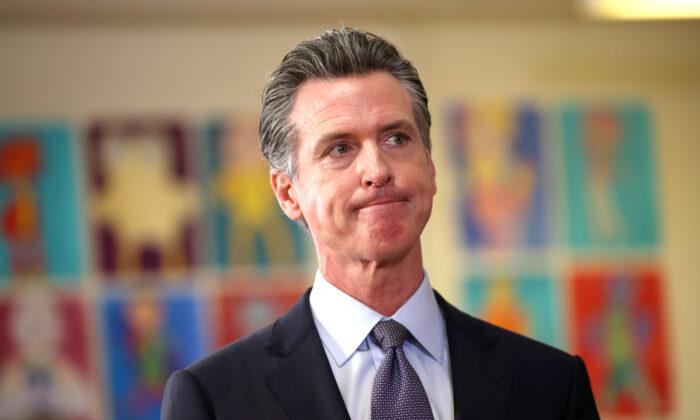Commentary
You read it here first in The Epoch Times. “California Budget Deal Numbers Don’t Add Up,” was my
headline on June 28, just after Gov. Gavin Newsom and the California Legislature passed their supposedly balanced budget for fiscal year 2023–24, which began on July 1.
I explained the budget kept “spending at 7.2 percent of Californians’ personal income—well above the 6.2 percent limit I have identified for 20 years. Above that limit, the state inevitably gets into budget trouble and has to enact more cuts. ... We could end up with a situation similar to the fall of 2008, as the Great Recession dug in. Revenues fell off a cliff.”
The California Legislative Analyst (LAO) just released its
forecast for 2024: “California Faces a $68 Billion Deficit. Largely as a result of a severe revenue decline in 2022‑23, the state faces a serious budget deficit. Specifically, under the state’s current law and policy, we estimate the Legislature will need to solve a budget problem of $68 billion in the upcoming budget process.”
The deficit came just two years after the state enjoyed a nearly $100 billion surplus. As I have written in these pages, that surplus was a once-in-a-generation chance to straighten out the state’s endemic budget rollercoaster, with revenues soaring in good times, then plunging in bad times. But that opportunity was missed.
‘Seiler’s Law’: 6.2 Percent Spending Limit
How did I know?Earlier, on Feb. 24, I
explained, “California Legislative Analyst Discovers ‘Seiler’s Law’ on Budget Spending Limit.” Seiler’s Law is the 6.2 percent limit. I won’t duplicate it here, but I included a chart from a 2010 article I wrote from CalWatchdog.com, a now defunct website.
Then I included a chart
produced by the California Legislative Analyst for its Feb. 15, 2023 Multiyear Assessment. that showed exactly the same thing. I’ll include that because it looks better than my chart, although they should have drawn a straight line across the graph at the 6.2 percent level to show exactly when that limit is exceeded. Note the spike the past few years:
Here are the specific ratio numbers from my calculations. (Mr. Newsom’s January budget proposal for fiscal 2024–25 will have updated estimates.)
- 2019–20: 5.56
- 2020–21: 5.87
- 2021–22: 7.39
- 2022–23: 7.96 (estimated)
- 2023–24: 7.10 (estimated)
The LAO didn’t give me credit for finding the 6.2 limit 20 years earlier. Perhaps they didn’t know about it. In any event, President Reagan used to have a plaque on his desk at the Oval Office that read, “There is no limit to the amount of good you can do if you don’t care who gets the credit.”
Unfortunately, neither Mr. Newsom nor the Legislature paid any heed to the warnings from either me or the LAO. And you’ll note two things from the chart. Every time the number went over 6.2 percent, the state ran a deficit and increased taxes: in the early 1990s under Gov. Pete Wilson; in the early 2000s under Gov. Gray Davis, a partial reason for his 2003 recall; and in the 2005–08 period under Gov. Arnold Schwarzenegger, who was elected in part to end what he called “the crazy deficit spending,” but after being sensible in his first two years in office, 2003–04, went on a spending spree.
Only under Gov. Jerry Brown, in office 2011–09, was budget number consistently kept under the 6.2 percent Seiler’s Law limit. Then Mr. Newsom came in in 2019 and promptly renewed the overspending folly.
Will They Ever Learn?
Overspending in California is like being on crack cocaine. It’s a tough habit to break. Even the two Republican governors, Mr. Wilson and Mr. Schwarzenegger, couldn’t do it. After Mr. Brown put the state in rehab for eight years, Mr. Newsom took California back to its old addiction.So what’s next? Spending cuts will be made. The state’s budget reserves, which the LAO estimates are $24 billion, will be tapped. And if we go by precedent, in 1991, 1993, and 2009 there were tax increases. The 1991 tax increase was $7 billion, a record. Then the 2009 tax increase of $13 billion was a new record.
But they never work. For the 2009 tax increase, the next year Rep. Tom McClintock (R-Calif.)
wrote: “The taxes were supposed to produce $13 billion in additional revenue. But after nine months, California’s sales tax collections are down $270 million; income tax collections are down $10 billion. The only major tax not raised—the corporate tax—is the only tax that’s producing more revenue—up about $2.4 billion in the same period.”
Florida Shows the Way
The $68 billion deficit and the ensuing budget wrangles that will consume the first half of 2024 will not enhance Mr. Newsom’s obvious presidential ambitions. This is going to play out on a national stage should President Biden’s health continue to deteriorate and Democratic presidential wannabes start jostling over who might take his place as the party’s nominee.
Meanwhile, Florida’s budget for fiscal 2024–25 is
estimated to enjoy a $7.6 billion surplus. And that’s after a $2.7 billion tax cut the past year signed by Gov. Ron DeSantis. The reason is, if you make your state government reasonable and not too costly, it attracts people who come there and pay taxes.
By contrast, California’s high-tax, overregulated economy repels taxpayers, actually reducing the state’s population in recent years, which in turn reduced the tax base. Taxes have consequences.
That reality was a theme in the recent DeSantis-Newsom debate I
analyzed in “Newsom and DeSantis Both Win Debate.” Mr. Newsom won by scoring points with the Democratic National Committee that could pick a replacement should Mr. Biden drop out. But Mr. DeSantis scored with Republican primary voters by contrasting his success in the Sunshine State with Mr. Newsom’s failure in the Golden State.
Mr. Newsom’s January budget document will be the next step in the wrangling over spending and taxation. With two-thirds supermajorities in both houses, Democrats in the Legislature will be able to push tax increases without any votes from Republicans. No doubt they will be pushing hard. So the question resolves to how much Mr. Newsom will agree to.
But as Mr. McClintock pointed out almost 14 years ago, when taxes are as high as they are in California, tax rate increases inevitably backfire, actually reducing revenues. Which will bring even deeper cuts.
Views expressed in this article are opinions of the author and do not necessarily reflect the views of The Epoch Times.








